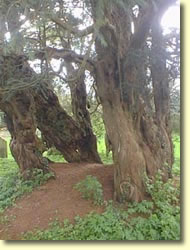 The
Village Church has served the needs of our local community for 800 years. It
is a place of prayer and peace, a constant reminder of God's presence in an
ever-changing world.
The
Village Church has served the needs of our local community for 800 years. It
is a place of prayer and peace, a constant reminder of God's presence in an
ever-changing world.
The structure is in constant need of restoration, a problem compounded at All Saints after a sustained attack by a persistent* Green Woodpecker that bored holes in the wooden shingles on the tower roof in search of nourishment.
(*I'm almost certain that was the word the vicar used)As a result a special All Saints Restoration Fund was set up to refurbish the spire and enhance the interior of the ancient building.


Much of this work has now been completed and the newly refurbished church, which had been closed through the summer for major repairs to the structure and interior,
reopened in time for the
Harvest Festival in 2001.
The scaffolding has at last been removed from the tower after the weather vane was replaced on the 20th April 2002.
Much more work is still needed and, in common with most Parish Churches, fund raising to maintain the building is a never ending activity.
Gilbert White, the Selborne naturalist, was curate at All Saints for many years before he took up his post as curate at Selborne, in the neighbouring parish.
Although the present church building dates back to the 1300's, structural changes took place in the 19th century under the influence of Rev Thomas Massey, rector for 62 years.
 Massey
was something of an eccentric with a penchant for building.
Massey
was something of an eccentric with a penchant for building.
He was responsible
for the construction of
'Masseys Folly', just
across the road from the Church, the building we now use as the Village
Hall.
The Rev. Massey died in 1919, before the building was completed, he is buried near the Church door, his grave marked with a Celtic cross.
The war memorials and a book of remembrance record the sacrifice of local people
killed in action in the two world wars. Other
memorials record lives of local people who have served both the church and community
in their lifetime.
Visitors to the church can see a stained glass window in the vestry designed by village resident Hugh Powell, who moved to Farringdon in 1958. His work repairing bomb damaged stained glass was much in demand. His also made a window in Southwark Cathedral in London.
Many a village lad mourned the passing of the old hand-pumped church organ in 1969 as it provided a ready source of pocket money.
Ancient wall paintings of an Apostle dating back to 1340 were discovered when layers of old lime wash began to flake off medieval plaster work. In 1988 experts were consulted to carry out an investigation, so that decisions could be made about conservation.
Two paintings were discovered - both 'Dooms' or 'Last Judgements', with Christ as the central figure displaying the wounds of his crucifixion. The paintings were faded in places and difficult to make out, but some details are still clear.
Unfortunately these paintings are in the loft space above the ceiling and are not accessible to visitors, although when the recent repairs were carried out it was discovered that the ends of the ceiling timber supports had crumbled away, with only the plaster work preventing an unscheduled descent, which would have given those of the congregation who were still conscious, a clear view of the old paintings.
The old yew in the churchyard, beside the path from the Lych gate, is certainly an ancient tree, the exact age is uncertain but possibly less than the 3,000 years claimed in more fanciful estimates. Whatever the true age, the author of the following verse was obviously convinced the Farringdon Yew was more than 2,000 years old.

Gilbert White
was curate here,
For nearly four and twenty years
He daily rode the rural track
From Selborne to All Saints and back.
But long before he came this way,
Old Farringdon had much to say —
For is it true the hollow yew,
When Christ was born, was far from new
ALL SAINTS CHURCH - Services, 2002/3